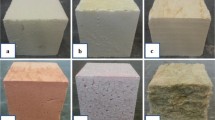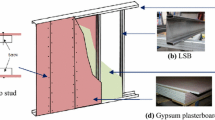Abstract
Shipping containers are increasingly adapted for modern modular construction of both permanent and mobile low-cost civilian-use structures, with the diversity and interchangeability of their uses suggesting the need for container-based modular structures to conform to standard fire safety requirements, notably insulation and integrity. Multi-storey structures in city centres consisting entirely of modified shipping containers, or shipping containers fitted into structural frames, are becoming more commonplace. Full-scale fire tests are generally rather expensive and can be complemented with systematic numerical studies of fire resistance times offered by a range of passive protection configurations and thermal transport properties. Noting that standardised fire resistance ratings have three components (structural, insulation, integrity), this study specifically considers fire resistance times offered by passive fire protection configurations, by performing a series of time-dependent finite element heat transfer analyses of passively protected side panel configurations. A set of reference curves with which to determine insulation resistance times in the context of the ISO 834–1 standard fire curve is presented, specifically for use in the rational fire safety design of modular structures constructed from shipping containers. Negligible literature is currently available on fire resistance ratings of shipping container structures.







Similar content being viewed by others
References
ISO 668. (2020) Series 1 freight containers. Classification, dimensions and ratings. International Organisation for Standardization, Geneva, Switzerland, 24.
EN 1993–1–2. (2005) Eurocode 3—design of steel structures—part 1−2: general rules—structural fire design. Eurocode 3.
EN 1991–1–2. (2002) Actions on structures —Part 1–2: General actions — Actions on structures exposed to fire. In Eurocode 1 (Vol. 3).
Buchanan AH, Abu AK (2016) Structural Design for Fire Safety, 2nd edn. John Wiley and Sons Ltd, Chichester, West Sussex, UK
EN 1364–1 (2015). Fire resistance tests for. Non-loadbearing elements. European Committee for Standardization, Brussels
EN 1363–1 (2020) Fire resistance tests. General requirements. European Committee for Standardization, Brussels
National Research Council (1978) Ships: Report. Washington, DC: The National Academies Press. https://doi.org/10.17226/20062.
De Koker N, Walls RS, Cicione A, Sander ZR, Löffel S, Claasen JJ, Rush D (2020) 20 dwelling large-scale experiment of fire spread in informal settlements. Fire Technology 23:1–22
Zha X, Zuo Y (2016) Finite element study of container structure under normal and high temperature. Mathematical Problems in Engineering. 2016:11–22
ISO 834–1 (1999) ISO 834–1:1999 -- Fire-resistance tests -- Elements of building construction -- Part 1: General requirements. In ISO: Brussels, Belgium.
Law A, Bisby L (2020) The rise and rise of fire resistance. Fire Saf J 103188:116
Hurley MJ (2016) Appendix 2: Thermophysical Property Data, SFPE Handbook of Fire Protection Engineering, Springer, New York.
Touloukian YS, Powell RW, Ho CY, Nicolaou MC (1974) Thermophysical properties of matter, Volume 10 - Thermal Diffusivity, IFI/Plenum, New York
Systémes D (2016) Abaqus 2016 Documentation. Dassault Systémes Simulia Corporation, Providence, RI, USA
ASFP (2014) Fire protection for structural steel in buildings, Vol 1. Association for Specialist Fire Protection, Hampshire, UK.
Clifton GC (2007) Design of composite steel floor systems for severe fires. Proceedings of 8th Pacific Structural Steel Conference - Steel Structures in Natural Hazards, PSSC 2007.
Wickström U (2016) Temperature calculation in fire safety engineering. Temperature Calculation in Fire Safety Engineering. 12:18–23
Author information
Authors and Affiliations
Corresponding author
Additional information
Publisher's Note
Springer Nature remains neutral with regard to jurisdictional claims in published maps and institutional affiliations.
Rights and permissions
About this article
Cite this article
Shuttleworth, S.M., De Koker, N. & Walls, R.S. Insulation Resistance Time Reference Curves for Specifying Passive Fire Protection for Modular Structures from Shipping Containers. Fire Technol 58, 133–147 (2022). https://doi.org/10.1007/s10694-021-01143-9
Received:
Accepted:
Published:
Issue Date:
DOI: https://doi.org/10.1007/s10694-021-01143-9




